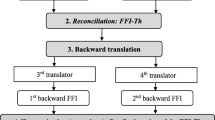Abstract
This study was performed to translate and transculturally adapt the English version of the Foot and Ankle Outcome Score (FAOS) into a Korean version, and to test psychometric properties of the Korean FAOS in terms of internal consistency, test–retest reliability, convergent validity, and dimensionality. Translation and transcultural adaptation of FAOS into a Korean version was performed according to internationally recommended guidelines. Internal consistency (N = 294) and test–retest reliability (N = 21) were evaluated. Convergent validity was analyzed using correlation with pain visual analogue scale (VAS) score. All subscales, except for the quality of life (Q) subscale (Cronbach’s alpha, 0.615), showed satisfactory internal consistency (Cronbach’s alpha > 0.7). Cronbach’s alpha of function in daily living (ADL) was highest (0.962), which might represent the redundancy of the items. All five subscales showed satisfactory reliability with ADL subscale showing the highest ICC (intraclass correlation coefficient; 0.851) and Q subscale the lowest ICC (0.718). Pain VAS score showed the highest correlation with pain (P) subscale of FAOS (r = 0.675, p < 0.001) and the lowest correlation with Q subscale (r = 0.495, p < 0.001). In the dimensionality test, a factor analysis was performed using the total items to rank their relative significance, which showed seven components solution. Considerable portion of the items showed a similar dimension according to their original subscales, except for ADL items. Translation and transcultural adaptation of FAOS into the Korean language was performed successfully. The items were understandable, and the subscales showed satisfactory test–retest reliability. Some minor revision might be needed to enhance the internal consistency of Q subscale and reduce the redundancy of ADL subscale.
Similar content being viewed by others
References
http://www.who.int/classifications/icf/en/. Accessed 5 December 2012
Roos EM, Toksvig-Larsen S (2003) Knee injury and osteoarthritis outcome score (KOOS)—validation and comparison to the WOMAC in total knee replacement. Health Qual Life Outcomes 1:17
Roos EM, Brandsson S, Karlsson J (2001) Validation of the foot and ankle outcome score for ankle ligament reconstruction. Foot Ankle Int 22:788–794
Knobloch K, Schreibmueller L, Longo UG, Vogt PM (2008) Eccentric exercises for the management of tendinopathy of the main body of the Achilles tendon with or without the AirHeel Brace. A randomized controlled trial. A: effects on pain and microcirculation. Disabil Rehabil 30:1685–1691
Karatepe AG, Gunaydin R, Kaya T, Karlibas U, Ozbek G (2009) Validation of the Turkish version of the foot and ankle outcome score. Rheumatol Int 30:169–173
Negahban H, Mazaheri M, Salavati M, Sohani SM, Askari M, Fanian H, Parnianpour M (2010) Reliability and validity of the foot and ankle outcome score: a validation study from Iran. Clin Rheumatol 29:479–486
Beaton DE, Bombardier C, Guillemin F, Ferraz MB (2000) Guidelines for the process of cross-cultural adaptation of self-report measures. Spine 25:3186–3191
Lee YK, Chung CY, Koo KH, Lee KM, Lee DJ, Lee SC, Park MS (2011) Transcultural adaptation and testing of psychometric properties of the Korean version of the Hip Disability and Osteoarthritis Outcome Score (HOOS). Osteoarthr Cartil 19:853–857
Salavati M, Mazaheri M, Negahban H, Sohani SM, Ebrahimian MR, Ebrahimi I, Kazemnejad A, Salavati M (2008) Validation of a Persian-version of Knee injury and Osteoarthritis Outcome Score (KOOS) in Iranians with knee injuries. Osteoarthr Cartil 16:1178–1182
Cronbach LJ, Warrington WG (1951) Time-limit tests: estimating their reliability and degree of speeding. Psychometrika 16:167–188
Fleiss JL, Levin BA, Paik MC (2003) Statistical methods for rates and proportions. Wiley, Hoboken
Streiner D, Norman G (2004) Health measurement scales. A practical guide to their development and use, 3rd edn. Oxford University Press, Oxford
Hair JF Jr, Anderson RE, Tatham RL, Black WC (1998) Multivariate data analysis, 5th edn. Prentice Hall, New York
Stevens JP (2002) Applied multivariate statistics for the social sciences, 5th edn. Taylor and Francis, Florence
Sharma S (1996) Applied Multivariate Techniques. John Wiley and Sons Inc, New York
McHorney CA, Tarlov AR (1995) Individual-patient monitoring in clinical practice: are available health status surveys adequate? Qual Life Res 4:293–307
Massof RW, Rubin GS (2001) Visual function assessment questionnaires. Surv Ophthalmol 45:531–548
Rerera R, Heneghan C, Badenoch D (2008) Statistics toolkit. Blackwell, Massachusetts
Roos EM, Brandsson S, Karlsson J (2001) Validation of the foot and ankle outcome score for ankle ligament reconstruction. Foot Ankle Int 22:788–794
Acknowledgments
The authors wish to thank Ewa Roos, PhD for permitting this study. We also thank Hyun Mi Kim, BS, and Mi Sun Ryu, BS for data collection.
Disclosures
None of the authors have conflicts of interest.
There was no funding source or financial support.
Author information
Authors and Affiliations
Corresponding author
Rights and permissions
About this article
Cite this article
Lee, K.M., Chung, C.Y., Kwon, S.S. et al. Transcultural adaptation and testing psychometric properties of the Korean version of the Foot and Ankle Outcome Score (FAOS). Clin Rheumatol 32, 1443–1450 (2013). https://doi.org/10.1007/s10067-013-2288-1
Received:
Revised:
Accepted:
Published:
Issue Date:
DOI: https://doi.org/10.1007/s10067-013-2288-1



